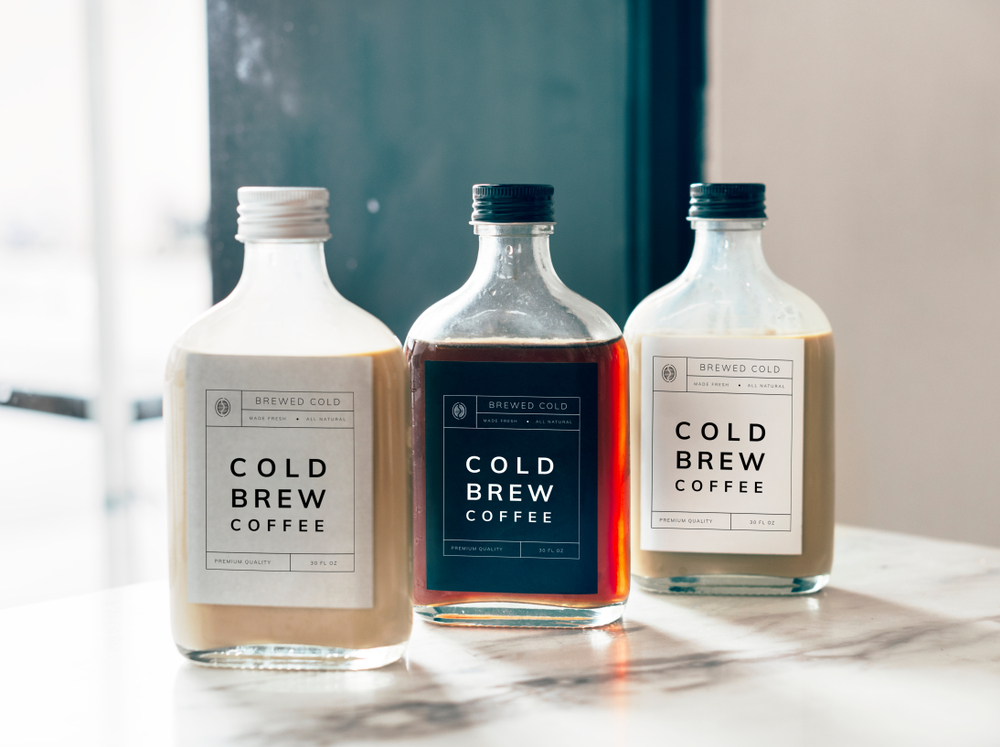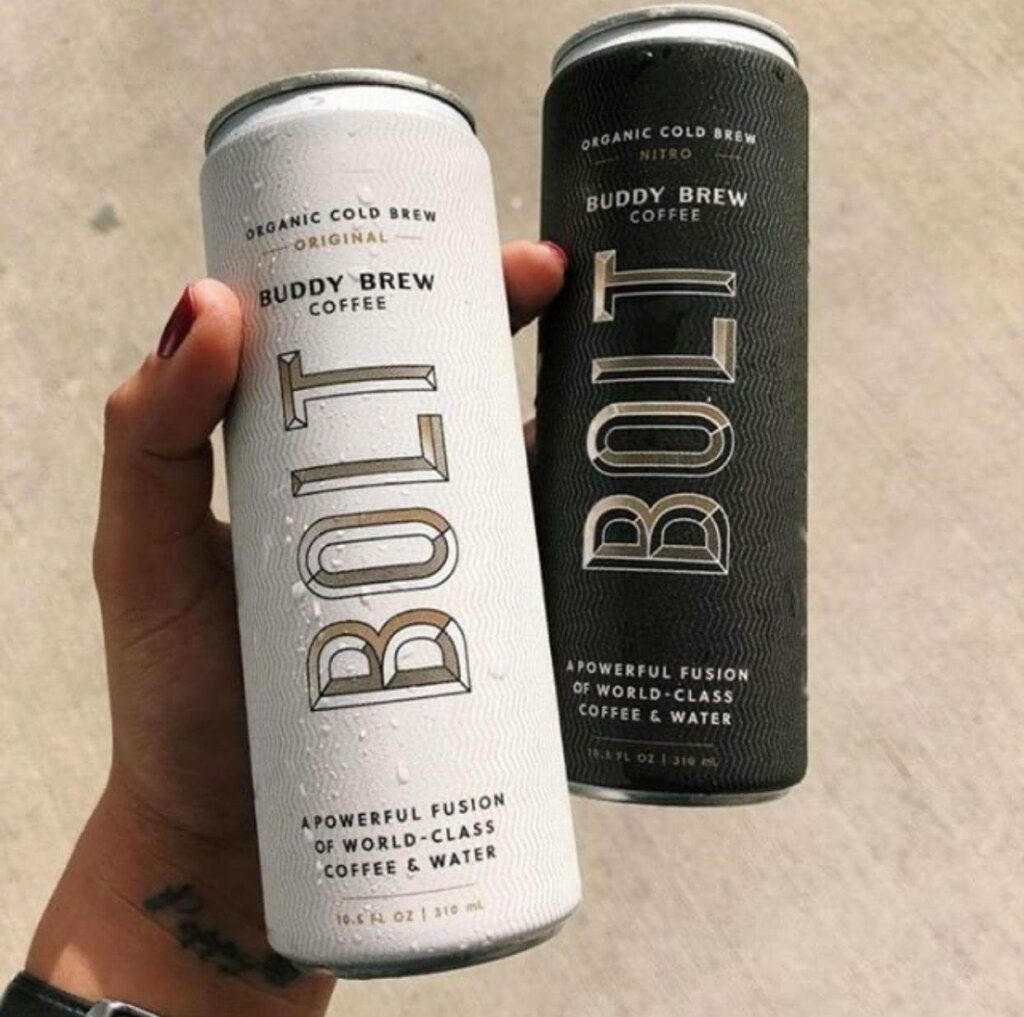Beverage Label: Principal Display Panel
On the front side of the packaging is the principal display panel, also known as the PDP. The principal display panel is the most visible part of the label and is designed to be displayed forward toward the customers on a shelf. The PDP is the front-facing part of the product. The principal display panel will include the statement of identity or common name of the beverage, such as energy drink or soda. Typically above the common name is the brand name.
The PCP will also include the weight or quantity of the contents. The statement provides the consumer with the total amount of liquid in the beverage container. Liquid is typically measured in ounces, milliliters, or liters. With cylindrical beverage packaging, it is required that 40% of the side area of the vessel must be covered by the PDP.
Lastly, health claims and nutritional claims may be present on the PDP. Nutritional claims are statements of nutritional value, such as being sugar-free or high in protein. Health claims may include claims such as their beverage being an immune booster. Other pieces of information may be included on the principal display panel but also may be included on the information panel. This includes the ingredients list information on the manufacturer distributor or packer and additional nutritional information.
Information Panel
The information panel on a beverage is typically placed on the right side of the principal display panel. It is here that the ingredients list, “Supplement Facts” panel, as well as information on the name and address of the business, manufacturer, distributor, or packer. Here is where a label would list if the manufacturer and distributor were different companies, and provide information on where the product was packaged. This is only required if this information is not divulged on the PDP. Here you would also place the nutritional labeling, ingredients list, and allergy labeling.
Depending on the type of drink, the label may require additional information. Wine bottle labels may need to list the origin of the drink, and juices will need to list the percentage of real fruit juice that is used in the beverage.
Nutritional Facts Panel
Within the nutrition facts panel it is required to include the following: sodium, dietary, fiber, cholesterol, total, carbohydrates, sugars, total, fat, protein, sugars, calcium, potassium, iron, and vitamin D. In some cases, other specific requirements may be enforced, depending on the location. With each nutrient, it is required to list the quantity per serving; this is determined by laboratory testing to analyze the contents of the product and potentially each ingredient if necessary. This allows a manufacturer to determine the percentage of daily value one single serving contains, which is typically based on a calorie diet of 2000 or 2500 per day. When working with a seasoned packaging and labeling manufacturer, you get access to our experience working with beverage labeling requirements and guidelines in the United States.
Beverage Nutrition Labeling Requirements
The Food and Drug Administration beverage label requirements clearly state that every beverage sold is required to have clear information regarding the nutritional contents of each beverage. This label is required to be accessible, and easy to find and read while providing an easily comprehensible list of ingredients. Nutritional labeling must also include information that is vital for the consumers including Daily Values, allergens, the presence of caffeine, and of course the full list of ingredients. Beverages must include each ingredient that is used in the beverage regardless of how long the list may be. This will include the main ingredients first followed by less prevalent ingredients like flavorings, acids, additives. Sub-ingredients may be listed in parenthesis on the nutrition label, listed after the main ingredient, or the sub-ingredients may be listed in full. Potential allergens must be listed to ensure that any consumer who may have a food and drink allergy will be able to clearly identify those ingredients. The most popular allergens must be included in this list. The major food allergens are fish, milk, crustaceans, shellfish, soybeans, sesame, wheat, tree, nuts, and peanuts.
All of these labeling requirements are extremely important not only to meet beverage nutrition label standards but also because they can save lives. Even in places that serve food, being able to clearly see ingredients helps restaurants and commercial kitchens clearly understand what ingredients are in the food they serve.
Label Design

Label design is almost as intricate as the contents that go into the label. Label design is determining the exact location of the PDP, the information panel, nutritional facts, supplement facts, and more. Factors that impact the label assigned will include things like the shape of the packaging, space on each side of the packaging, and whether or not certain pieces of information can fit into certain sections without ignoring guidelines and standards. Typeface size and spacing are particular for each section and must be handled appropriately without ignoring guidelines and standards.
The size of the font depends on each section. Nutritional facts, key nutrients, percentage of daily value, serving size, nutrients, measurements, vitamins, and minerals, and table labels all will have specific typeface and size. While it is more common to see a nutritional fax label printed in black-and-white on a neutral background, manufacturers are allowed to use other solid colors. It is important to pay attention to the typeface and size for each section of the label. The size of the font depends on each section. Nutritional facts, key nutrients, percentage of daily value, serving size, nutrients, measurements, vitamins, and minerals, and table labels all will have specific typeface and size guidelines that must be followed.
In certain circumstances, there are exceptions to the placement of different sections. In some cases where the nutritional facts label will not fit vertically part of the label may be placed alongside to the right. The beverage labels may be in different forms like an adhesive label that is adhered to the outside of a bottle, or even a label that has been printed or fused to a canned beverage.
Mammoth Labels & Packaging – Beverage Labeling

With a deep history in product labeling, Mammoth Labels & Packaging easily navigates FDA requirements and guidelines to put your mind at ease. We offer our expertise on labeling requirements and work closely with our clients to ensure their labels meet all guidelines before the labels are fully approved for print.
For over six decades we have built and supported relationships with clients in every region of the country. As beverage and food labeling professionals we believe in raising the standards in both customer services and our own label products. Through many shifts in the labeling industry, we have adapted and continued to grow as printing technology and capabilities have evolved.
Mammoth Labels & Packaging delivers premium packaging and container labeling services for clients across many different industries. We have an extensive background in industries including beverages, food labeling, candles, deli meat & cheese labels, health & beauty, supplements, wine & spirits, cannabis & CBD, Industrial & Manufacturing, and more.
Printing and More with Mammoth
Mammoth Labels & Printing has long been known for our expert printing of food and beverage labels, however, our process goes far beyond printing. We work with clients who are in all stages of their product including working with them to mock up a new label from complete scratch. Our design team can utilize existing assets that a client provides, whether it be inspiration or artwork they want included in the final label design. We design, proof, print, ship, and work with manufacturers and distributors to set up in-house printing operations. To learn more about beverage labeling, and how Mammoth can assist you with labeling regulations please reach out to our staff today.


